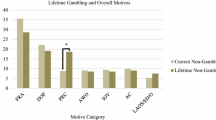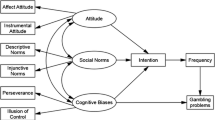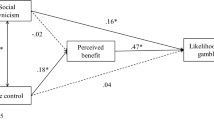Abstract
Gambling is a serious concern for society because it is highly addictive and is associated with a myriad of negative outcomes. The current study applied the Reasoned Action Model (RAM) to understand and predict gambling intentions and behavior. Although prior studies have taken a reasoned action approach to understand gambling, no prior study has fully applied the RAM or used the RAM to predict future gambling. Across two studies the RAM was used to predict intentions to gamble, past gambling behavior, and future gambling behavior. In study 1 the model significantly predicted intentions and past behavior in both a college student and Amazon Mechanical Turk sample. In study 2 the model predicted future gambling behavior, measured 2 weeks after initial measurement of the RAM constructs. This study stands as the first to show the utility of the RAM in predicting future gambling behavior. Across both studies, attitudes and perceived normative pressure were the strongest predictors of intentions to gamble. These findings provide increased understanding of gambling and inform the development of gambling interventions based on the RAM.
Similar content being viewed by others
Notes
Point-biserial correlations between gender and the RAM constructs can be equivalently presented in the form of independent samples t-tests. For Study 1a (student sample) there were significant gender differences on: attitudes (t(98) = 2.41, p = .018) with males (M = 3.22, SD 1.27) significantly higher than females (M = 2.53, SD 1.32), perceived normative pressure (t(98) = 2.82, p = .006) with males (M = 2.59, SD 1.05) significantly higher than females (M = 1.92, SD 1.09), PBC (t(98) = 2.87, p = .005) with males (M = 5.45, SD 1.32) significantly higher than females (M = 4.63, SD 1.29), and intentions (t(98) = 2.82, p = .006) with males (M = 2.61, SD 1.57) significantly higher than females (M = 1.79, SD 1.21). For Study 1b (Mturk sample) there were significant gender differences on: attitudes (t(93) = 2.87, p = .005) with males (M = 3.79, SD 1.06) significantly higher than females (M = 3.00, SD 1.60), and perceived normative pressure (t(93) = 2.01, p = .047) with males (M = 2.91, SD 1.02) significantly higher than females (M = 2.45, SD 1.21). There were no significant differences in study 1b for the gender on PBC or intentions.
When included in the regression analysis, gender served as a significant predictor of past behavior for the Study 1b Mturk sample (β = −.207, p = .017) but only accounted for an increase of 3% variance beyond intention and PBC.
Though the RAM (Fishbein and Ajzen 2010) would not predict any significant contribution of attitudes and perceived normative pressure in predicting past gambling behavior, additional regression analyses were run in order to determine the potential direct effects of these variables. When included in the regression analysis for study 1a, the overall model was significant F(4, 95) = 13.70, p < .001, R 2 = .37 with attitudes (β = −.128, p = .274) not serving as a significant predictor and perceived normative pressure (β = .255, p = .038) serving as a significant predictor of past behavior. When included in the regression analysis for study 1b, the overall model was significant F(4, 90) = 10.63, p < .001, R 2 = .32 with attitudes (β = .113, p = .402) not serving as a significant predictor and perceived normative pressure (β = −.151, p = .242) also not serving as a significant predictor of past behavior. These analyses were not included due to theoretical justification as well as the minimal increases (5%-study 1a, 3%-study 1b) in variance explained when including the variables in the models.
When attitudes and perceived normative pressure were included in the regression analysis predicting past behavior for study 2, the overall model was significant F(4221) = 47.34, p < .001, R 2 = .45 with attitudes (β = .084, p = .234) not serving as a significant predictor and perceived normative pressure (β = .040, p = .504) also not serving as a significant predictor of past behavior. These variables were not included due to theoretical justification as well as the larger model showing no difference in variance explained.
When attitudes and perceived normative pressure were included in the regression analysis predicting future behavior for study 2, the overall model was significant F(5129) = 31.94, p < .001, R 2 = .55 with attitudes (β = .038, p = .636) not serving as a significant predictor and perceived normative pressure (β = .059, p = .387) also not serving as a significant predictor of past behavior. These variables were not included due to theoretical justification as well as the minimal increase (1%) in variance explained when including the variables in the model.
References
Ajzen, I. (1985). From intentions to actions: A theory of planned behavior. In J. Kuhl & J. Beckmann (Eds.), Action-control: From cognition to behavior (pp. 11–39). New York: Springer. doi:10.1007/978-3-642-69746-3_2.
Ajzen, I., & Fishbein, M. (1980). Understanding attitudes and predicting social behavior. Englewood Cliffs, NJ: Prentice-Hall.
Albarracín, D., Johnson, B. T., Fishbein, M., & Muellerleile, P. A. (2001). Theories of reasoned action and planned behavior as models of condom use: A meta-analysis. Psychological Bulletin, 127, 142–161. doi:10.1037/0033-2909.127.1.142.
Blinn-Pike, L., Worthy, S. L., & Jonkman, J. N. (2007). Disordered gambling among college students: A meta-analytic synthesis. Journal of Gambling Studies, 23, 175–183. doi:10.1007/s10899-006-9036-2.
Buhrmester, M., Kwang, T., & Gosling, S. D. (2011). Amazon’s Mechanical Turk a new source of inexpensive, yet high-quality, data? Perspectives on Psychological Science, 6, 3–5. doi:10.1177/1745691610393980.
Downs, D. S., & Hausenblas, H. A. (2005). The theories of reasoned action and planned behavior applied to exercise: A meta-analytic update. Journal of Physical Activity and Health, 2, 76–97.
Dussault, F., Brendgen, M., Vitaro, F., Carbonneau, R., Boivin, M., & Tremblay, R. E. (2016). Co-morbidity between gambling problems and depressive symptoms: A longitudinal perspective of risk and protective factors. Journal of Gambling Studies. doi:10.1007/s10899-015-9546-x.
Fishbein, M. (2008). A reasoned action approach to health promotion. Medical Decision Making, 28, 834–844. doi:10.1177/0272989X08326092.
Fishbein, M., & Ajzen, I. (2010). Predicting and changing behavior: The reasoned action approach. New York: Psychology Press.
Gainsbury, S. M., Russell, A., Hing, N., Wood, R., Lubman, D., & Blaszczynski, A. (2015). How the Internet is changing gambling: Findings from an Australian prevalence survey. Journal of Gambling Studies, 31, 1–15. doi:10.1007/s10899-013-9404-7.
Gainsbury, S., Wood, R., Russell, A., Hing, N., & Blaszczynski, A. (2012). A digital revolution: Comparison of demographic profiles, attitudes and gambling behavior of Internet and non-Internet gamblers. Computers in Human Behavior, 28, 1388–1398. doi:10.1016/j.chb.2012.02.024.
Granero, R., Penelo, E., Stinchfield, R., Fernandez-Aranda, F., Savvidou, L. G., Fröberg, F., et al. (2014). Is pathological gambling moderated by age? Journal of Gambling Studies, 30, 475–492. doi:10.1007/s10899-013-9369-6.
Grant, J. E., Kushner, M. G., & Kim, S. W. (2002). Pathological gambling and alcohol use disorder. Alcohol Research and Health, 26, 143–150.
Guerra, A. L., & Braungart-Rieker, J. M. (1999). Predicting career indecision in college students: The roles of identity formation and parental relationship factors. The Career Development Quarterly, 47, 255–266. doi:10.1002/j.2161-0045.1999.tb00735.x.
Harris, C. R., Jenkins, M., & Glaser, D. (2006). Gender differences in risk assessment: Why do women take fewer risks than men?. Judgment and Decision Making, 1, 48–63. Retrieved from http://search.proquest.com/docview/1010959354?accountid=7098.
Kessler, R. C., Hwang, I., LaBrie, R., Petukhova, M., Sampson, N. A., Winters, K. C., et al. (2008). DSM-IV pathological gambling in the National Comorbidity Survey Replication. Psychological Medicine, 38, 1351–1360. doi:10.1017/S0033291708002900.
Kline, P. (2000). Handbook of psychological testing. London: Routledge.
Kline, R. (2011). Principles and practice of structural equation modeling (3rd ed.). New York: The Guilford Press.
Larimer, M. E., & Neighbors, C. (2003). Normative misperception and the impact of descriptive and injunctive norms on college student gambling. Psychology of Addictive Behaviors, 17, 235–243. doi:10.1037/0893-164X.17.3.235.
Lee, H. S. (2013). Predicting and understanding undergraduate students’ intentions to gamble in a casino using an extended model of the theory of reasoned action and the theory of planned behavior. Journal of Gambling Studies, 29, 269–288. doi:10.1007/s10899-012-9302-4.
Lorains, F. K., Cowlishaw, S., & Thomas, S. A. (2011). Prevalence of comorbid disorders in problem and pathological gambling: Systematic review and meta-analysis of population surveys. Addiction, 106, 490–498. doi:10.1111/j.1360-0443.2010.03300.x.
Madden, T. J., Ellen, P. S., & Ajzen, I. (1992). A comparison of the theory of planned behavior and the theory of reasoned action. Personality and Social Psychology Bulletin, 18, 3–9. doi:10.1177/0146167292181001.
Mageau, G. A., Vallerand, R. J., Rousseau, F. L., Ratelle, C. F., & Provencher, P. J. (2005). Passion and gambling: Investigating the divergent affective and cognitive consequences of gambling. Journal of Applied Social Psychology, 35, 100–118. doi:10.1111/j.1559-1816.2005.tb02095.x.
Martin, R. J., Nelson, S., Usdan, S., & Turner, L. (2011). Predicting college student gambling frequency using the Theory of Planned Behavior: Does the theory work differently for disordered and non-disordered gamblers. Analysis of Gambling Behavior, 5, 45–58.
Martin, R. J., Usdan, S., Nelson, S., Umstattd, M. R., LaPlante, D., Perko, M., et al. (2010). Using the theory of planned behavior to predict gambling behavior. Psychology of Addictive Behaviors, 24, 89–97. doi:10.1037/a0018452.
May, R. K., Whelan, J. P., Steenbergh, T. A., & Meyers, A. W. (2003). The gambling self-efficacy questionnaire: An initial psychometric evaluation. Journal of Gambling Studies, 19, 339–357. doi:10.1023/A:1026379125116.
Meyer, G., & Fabian, T. (1992). Delinquency among pathological gamblers: A causal approach. Journal of Gambling Studies, 8, 61–77. doi:10.1007/BF01881469.
Moore, S. M., & Ohtsuka, K. (1997). Gambling activities of young Australians: Developing a model of behavior. Journal of Gambling Studies, 13, 207–236. doi:10.1023/A:1024979232287.
Moore, S. M., & Ohtsuka, K. (1999). The prediction of gambling behavior and problem gambling from attitudes and perceived norms. Social Behavior and Personality: An International Journal, 27, 455–466. doi:10.2224/sbp.1999.27.5.455.
Morasco, B. J., Pietrzak, R. H., Blanco, C., Grant, B. F., Hasin, D., & Petry, N. M. (2006). Health problems and medical utilization associated with gambling disorders: Results from the National Epidemiologic Survey on Alcohol and Related Conditions. Psychosomatic Medicine, 68, 976–984. doi:10.1097/01.psy.0000238466.76172.cd.
Nalpas, B., Yguel, J., Fleury, B., Martin, S., Jarraud, D., & Craplet, M. (2011). Pathological gambling in treatment-seeking alcoholics: A national survey in France. Alcohol and Alcoholism, 46, 156–160. doi:10.1093/alcalc/agq099.
Neighbors, C., Lostutter, T. W., Larimer, M. E., & Takushi, R. Y. (2002). Measuring gambling outcomes among college students. Journal of Gambling Studies, 18, 339–360. doi:10.1023/A:1021013132430.
Neighbors, C., Lostutter, T. W., Whiteside, U., Fossos, N., Walker, D. D., & Larimer, M. E. (2007). Injunctive norms and problem gambling among college students. Journal of Gambling Studies, 23, 259–273. doi:10.1007/s10899-007-9059-3.
Nowak, D. E., & Aloe, A. M. (2014). The prevalence of pathological gambling among college students: A meta-analytic synthesis, 2005–2013. Journal of Gambling Studies, 30, 819–843. doi:10.1007/s10899-013-9399-0.
Petry, N. M., Blanco, C., Stinchfield, R., & Volberg, R. (2013). An empirical evaluation of proposed changes for gambling diagnosis in the DSM-5. Addiction, 108, 575–581. doi:10.1111/j.1360-0443.2012.04087.x.
Shaffer, H. J., Hall, M. N., & Vander Bilt, J. (1999). Estimating the prevalence of disordered gambling behavior in the United States and Canada: A research synthesis. American Journal of Public Health, 89, 1369–1376. doi:10.2105/AJPH.89.9.1369.
Sheeran, P. (2002). Intention-behavior relations: A conceptual and empirical review. In W. Strobe & M. Hewstone (Eds.), European review of social psychology (pp. 1–30). Chichester: Wiley.
Sheeran, P., & Orbell, S. (1999). Augmenting the theory of planned behavior: Roles for anticipated regret and descriptive norms1. Journal of Applied Social Psychology, 29, 2107–2142. doi:10.1111/j.1559-1816.1999.tb02298.x.
Spunt, B. (2002). Pathological gambling and substance misuse. Substance Use and Misuse, 37, 1299–1304. doi:10.1081/JA-120004186.
State Gambling Laws. (2016). Retrieved from http://statelaws.findlaw.com/gambling-and-lotteries-laws/gambling.html.
Thrasher, R. G., Andrew, D. P., & Mahony, D. F. (2011). The efficacy of a modified theory of reasoned action to explain gambling behavior in college students. Journal of Gambling Studies, 27, 499–516. doi:10.1007/s10899-010-9215-z.
Wardle, H., Griffiths, M. D., Orford, J., Moody, A., & Volberg, R. (2012). Gambling in Britain: A time of change? Health implications from the British Gambling Prevalence Survey 2010. International Journal of Mental Health and Addiction, 10, 273–277. doi:10.1007/s11469-011-9319-4.
Webb, T. L., & Sheeran, P. (2006). Does changing behavioral intentions engender behavior change? A meta-analysis of the experimental evidence. Psychological Bulletin, 132, 249–268. doi:10.1037/0033-2909.132.2.249.
Wu, A. M., & Tang, C. S. K. (2012). Problem gambling of Chinese college students: Application of the theory of planned behavior. Journal of Gambling Studies, 28, 315–324. doi:10.1007/s10899-011-9250-4.
Yzer, M. (2012). Perceived behavioral control in reasoned action theory a dual-aspect interpretation. The Annals of the American Academy of Political and Social Science, 640, 101–117. doi:10.1177/0002716211423500.
Author information
Authors and Affiliations
Corresponding author
Ethics declarations
Conflict of interest
The authors declare that they have no conflict of interest.
Ethical Approval
All procedures performed in the current studies regarding human participants were in accordance with the ethical standards of the Texas Tech University and Ball State University institutional review boards and with the 1964 Helsinki declaration and its later amendments or comparable ethical standards.
Rights and permissions
About this article
Cite this article
Dahl, E., Tagler, M.J. & Hohman, Z.P. Gambling and the Reasoned Action Model: Predicting Past Behavior, Intentions, and Future Behavior. J Gambl Stud 34, 101–118 (2018). https://doi.org/10.1007/s10899-017-9702-6
Published:
Issue Date:
DOI: https://doi.org/10.1007/s10899-017-9702-6




